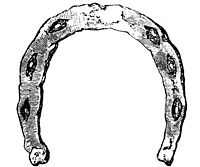years ago. It is about 4¼ inches long, has the six oval cavities, and calkins rolled-over and welded (fig. 89).
In the British Museum there is also a specimen, procured while making a sewer in 1833, in Fenchurch Street, London. Fragments of Roman pottery, boars' teeth, and other articles, were found with it. It is thin and light, has the nail-holes of the characteristic number and shape; narrows a little towards the heels, where there are calkins, and shows marks of wear. It measures four and three eighths inches long, and four inches wide. It is narrower across the toe than several of the others examined, and resembles somewhat the third York specimen (fig. 90).
In August, 1854, there was discovered at Gloucester, at the depth of some nine or ten feet from the surface, and mingled with numerous fragments of Roman fictilia, the outer half of a strong iron horse-shoe, with one of the large fiat-headed nails already described remaining in one of the three holes. It is exactly similar, in size and make, to the last-mentioned shoe.
Another shoe precisely like it, but of rather larger dimensions, was met with beneath a Roman road at Inne-


